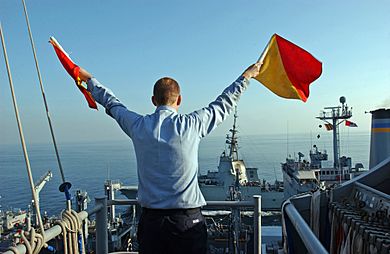Flag semaphore facts for kids

Flag semaphore is a cool way to send messages using flags! It's a system where people hold flags (or sometimes just their hands) in different positions to share information from far away. Each position of the flags stands for a letter, a number, or a special message.
This system became very popular for communicating at sea in the 1800s. Sailors used it a lot. Even today, it's still used during special operations at sea, like when ships need to refuel. It's also a good way to send emergency messages during the day. At night, people can use lighted sticks instead of flags.
Contents
How Flag Semaphore Works Today
The flag semaphore system we use now has two short poles with square flags. A person sending the message holds one pole in each hand. They move their arms into different positions, and each position means a specific letter of the alphabet or a number.
When signaling, the flags usually don't overlap, except when they are in the "rest" position. The colors of the flags can be different depending on where the signals are being sent. At sea, the flags are red and yellow. On land, they are white and blue. The flags just make the signals easier to see; you can even use your bare hands if you need to!
What the Characters Mean
Here are the 30 main semaphore characters. Imagine you are looking at the person sending the signal:
To send numbers, the sender first signals "Numerals." To switch back to letters, they signal "J."
When someone wants to start sending a message, they use the "Attention" signal. The person receiving the message then signals "Ready to receive." They do this by raising both flags straight up over their head and then dropping them to the rest position. Once the message is done, the sender signals "Ready to receive" again. The receiver can then signal "Attention" if they want to send a message back.
Where Flag Semaphore Came From
Flag semaphore started in 1866. It was inspired by an older communication system called the "optical telegraph." Optical telegraphs used big towers on land with large, moving arms. These towers were great for sending messages across land, but they were too big and hard to use on ships.
So, flag semaphore was invented as a smaller, handheld version. This made it easy for ships to talk to each other or to the shore when they were close enough. Even though the optical telegraph was replaced by the electric telegraph before flag semaphore became popular, the flag system still used many of the same codes.
Japanese Semaphore
The Japanese navy and merchant ships also use a flag semaphore system, but it's adapted for the Japanese language. The Japanese writing system has many more characters than the Latin alphabet. Because of this, most Japanese characters need two flag positions to be shown. Some need three, and a few only need one.
In the Japanese system, the left flag is solid white, and the right flag is solid red. The movements of the flags are different from the "rotary dial" system used for English letters. Instead, the flag movements show the angles of the brush strokes used when writing in the Japanese katakana script. For example, the character for "O" (オ) is drawn with a horizontal line, then a vertical line, and then a slant. The flag movements follow this same order. The right arm, holding the red flag, moves like a pen would, but in a mirror image so the person watching sees the correct pattern.
Just like in telegraphy, the katakana script is used to write down messages as they are received. The Japanese system also shows the number 0 by moving the flags in a circle. Numbers from 1 to 9 are shown using a "rotary dial" system, but it's different from the one used for European languages.
Modern Uses of Flag Semaphore
Flag semaphore is still used in many interesting ways today. For example, people sometimes use semaphore flags to communicate in the mountains where it's hard to use radios or talk. Even the Royal Canadian Mounted Police have used hand semaphore (without flags) in these situations.
Some beach rescue teams, like the Ocean City, Maryland Beach Patrol, use semaphore flags to talk to each other between lifeguards.
You might have seen semaphore characters in art too! A famous example is the peace symbol. This symbol was created in 1958 for the Campaign for Nuclear Disarmament. It combines the semaphore signals for the letters "N" (for Nuclear) and "D" (for Disarmament) inside a circle.
Along with Morse code, flag semaphore is still taught and used by the US Navy. It's also a subject that young people in Scouts learn as part of their training.
In a funny April Fools' Day joke in 2007, a group called the Internet Engineering Task Force even suggested a "Semaphore Flag Signaling System." This was a humorous idea about sending Internet messages using a line of flag semaphore operators!
See also
 In Spanish: Semáforo (alfabeto) para niños
In Spanish: Semáforo (alfabeto) para niños
- Flag signals
- Heliograph
- International Code of Signals
- International maritime signal flags
- Railway signalling
- Aircraft marshalling
- Optical landing system
- Semaphore line
- Signal lamp
- Substitute flag
- Traffic guard


